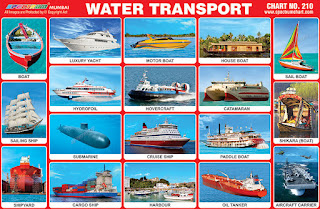Boat – A boat is a
vehicle used to travel on water. It is smaller than a ship and can
be lifted out of the water and carried on a ship. Some boats have
sails, some are powered by rowing with oaks and some use motors.
Boats are usually made of wood. However, some parts are made of
metals like steel and aluminium.
Sailing Ship – A sailing
ship is a big boat with sails which catch the wind. The wind pushes
the boat along. A sailing ship had a rig of at least three masts,
square rigged on all of them. They were very important for trade as
well as for war between 15th & 19th
century.
Shipyard – Shipyards are
places where ships are repaired and built. Shipyards are constructed
nearby the sea or tidal rivers to allow easy access for their ships.
The site of a large shipyard will contain many specialised cranes,
dry docks, slipways, dust-free warehouses, painting facilities and
extremely large areas for fabrication of the ships.
Luxury Yacht – A yacht is
a recreational boat or ship. Luxury yachts are mainly used for
leisure purpose. Luxury yachts have every modern convenience, from
air conditioning to television also comforts such as hot water,
pressurised water systems, and refrigerators.
Motor Boat – A motorboat
is a boat which is powered by an engine. Motorboats vary greatly in
size and configuration, from the four-meter, open centre console
type to the luxury mega-yachts capable of crossing an ocean.
House Boat – A houseboat
is a boat that has been designed or modified to be used primarily as
a home. Some houseboats are not motorised, because they are usually
moored, kept stationary at a fixed point and often tethered to land
to provide utilities. In India, houseboats are common on the
backwaters of Kerala and on the Dal Lake in Srinagar in Jammu and
Kashmir.
Hydrofoil – A hydrofoil
is a lifting surface or foil, that operates in water. They are
similar in appearance and purpose to aerofoils used by aeroplanes.
Boats that use hydrofoil technology are also simply termed
hydrofoils. As a hydrofoil craft gains speed, the hydrofoils lift
the boat's hull out of the water, decreasing drag and allowing
greater speeds.
Hovercraft – A
hovercraft, also known as an air-cushion vehicle or ACV, is a craft
capable of travelling over land, water, mud or ice and other
surfaces. They are now used throughout the world as specialised
transports in disaster relief, coastguard, military and survey
applications as well as for sport or passenger service.
Catamaran – A catamaran
is a multi-hulled watercraft featuring two parallel hulls of equal
size. Catamarans range in size from small sailing or rowing vessels
to large naval ships and car ferries.
Submarine – A submarine
is a watercraft capable of independent operation underwater. Most
large submarines are war vessels. They were almost always designed
to be used for war. Submarines would try to sink enemy ships by
crude methods. Submarines can work at greater depths than are
survivable or practical for human divers.
Cruise Ship – A cruise
ship is a large ship with sleeping cabins and other facilities that
takes people on holiday and vacation trips. Today's cruise ships are
like floating hotels. They have a complete hospitality staff as well
as the usual ship's crew. The largest cruise ships have casinos,
shops, many restaurants, theatres for entertainment and movies,
several pools, a gym and a running track.
Paddle Boat – A paddle
boat is a steamship powered by a steam engine that drives paddle
wheels to propel the craft through the water. Modern paddle wheeler's
may be powered by diesel engines. Save for tourism and small
pleasure paddle boats, paddle boat is largely superseded by the
screw propeller and other marine propulsion systems that have a
higher efficiency, especially in rough or open water.
Cargo Ship – A cargo ship
carries cargo, goods and materials from one port to another.
Thousands of cargo carriers travel on the world's seas and oceans
each year and handle most international trade. Cargo ships are
usually specially designed for a special task, often carrying tools
like cranes to load and unload.
Harbour - A harbour is a
place where ships, boats and barges may seek shelter. Harbour is a
facility built for loading and unloading vessels and dropping off
and picking up passengers. Harbours can be natural or artificial. An
artificial harbour can have deliberately constructed breakwaters,
sea walls or jetty's or they can be constructed by dredging.
Oil Tanker – An oil
tanker is a merchant ship designed for the bulk transport of oil.
Crude tankers move large quantities of unrefined crude oil from its
point of extraction to refineries. Product tankers, generally much
smaller, are designed to move petrochemicals from refineries to
points near consuming markets.
Sail Boat – A sailboat is
a boat propelled partly or entirely by sails smaller than a sailing
ship. Usually, a sailboat has two sails, a mainsail and a head sail
or jib. When the wind blows from behind, there can be used an extra
sail, a spinnaker.
Shikara – Shikara is a
type of wooden boat found on Dal Lake and other water bodies of
Srinagar. Shikara's are of varied sizes and are used for multiple
purposes, including transportation of people. Shikara's are still
used for fishing, harvesting aquatic vegetation and transport, while
most are covered with tarpaulins and are used by tourists.
Aircraft Carrier – An
aircraft carrier is a warship that serves as a seagoing airbase,
equipped with a full-length flight deck and facilities for carrying,
arming, deploying and recovering aircraft. The top of an aircraft
carrier is called the flight deck and looks like a small airport.


No comments:
Post a Comment